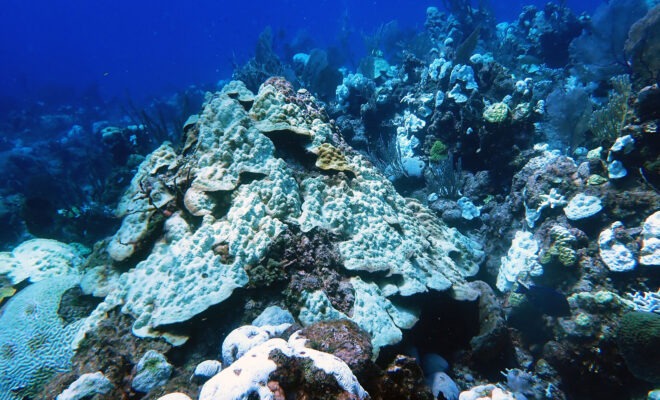The summer of 2023 was record-breaking in its heat, affecting not just humans but a wide array of animals, including those in the sea. The ocean’s temperature soared, subjecting its inhabitants to sweltering conditions, making them feel as if they were in a hot tub. Among these, coral reefs stand out for their rich biodiversity, providing a home for a quarter of all marine species. Corals, which are actually animals themselves, play a pivotal role in reef construction by secreting calcium carbonate skeletons. The corals can also feel the heat and in excess it can distress them, leading to a phenomenon called coral bleaching. This occurs when stressed corals expel their zooxanthellae, the algae that lives within them and supplies them with not only the majority of their nutritional needs but also gives them their vibrant hues. Consequently, the corals lose their color, turning an eerie white as if bleached. If conditions remain stressful for the coral they cannot regain their zooxanthellae and in turn lose their main source of energy and die. Last summer’s intense heatwave triggered a widespread bleaching event, transforming the once-vibrant Bahamian coral reefs and those across the Caribbean into stark, white landscapes as countless corals bleached seemingly overnight.
For some, the water is just right
Unfortunately, coral reefs in South Eleuthera were not spared. Many species of corals on the reef have bleached bright white. But despite the mass bleaching, some select corals remain unfazed. While some of the corals bleached fully, there were some that only partially bleached, appearing slightly pale but not fully white, and some that didn’t even bleach at all! These corals were able to resist the high temperatures and continue business as usual, showing little to no signs of stress. Similarly to humans, individuals of the same species of coral despite belonging to the same group, have slightly different genetic makeups. These genetic differences explain why some people have shellfish allergies while others don’t. As it relates to corals it allows for some corals to withstand the heat better than others, making them more resistant simply because they were born that way!
But why was it so hot?
Global warming is characterized by the gradual increase in Earth’s average temperature. This is primarily due to the rising levels of greenhouse gases like CO2 in our atmosphere produced by human activities like burning fossil fuels and deforestation. The accumulation of these gases in the atmosphere causes a greenhouse effect. While this effect is vital for maintaining the Earth’s warmth, the excessive release of greenhouse gases has intensified this natural process, resulting in an ongoing elevation of global temperatures—a condition we know as global warming.
Hope for the future
Time ushered in the end of summer, and the once-warm waters have now cooled down. But, as with all natural disasters, left behind in their wake is a trail of destruction. To gauge the impact of the past summer’s heatwave, researchers from The Bahamas Coral Innovation Hub based at the Cape Eleuthera Institute have been visiting various reefs in South Eleuthera. Notably, a reef at the Schooner Cays, located offshore of Cape Eleuthera, had an abundance of staghorn coral—a vital yet critically endangered species that forms complex structures on the reef providing habitat for diverse marine life. Devastatingly, a mass die-off in the 1980s decimated up to 90% of this coral’s populations, making thriving reefs such as this a rare sight. The recent visit to Schooner Cays revealed a somber scene, a field of dead coral, that had succumbed to the bleaching event, overwhelmed by algae, their whiteness replaced by a green fuzz. Yet, amidst the loss, some corals were still alive and thriving, showing remarkable thermal resilience and offering a beacon of hope for the future of coral reefs. The researchers observed various fish species still frequenting the reef, utilizing the staghorn coral’s skeleton as shelter, proving that even in the aftermath of global warming’s devastation, life finds a way.

Looking forward
As another summer draws near, we must brace ourselves for the onslaught of even hotter temperatures to come. The ongoing rise in human activities is expected to escalate the emission of greenhouse gases, further intensifying the Earth’s temperatures due to the effects of climate change. Reducing our carbon footprint is crucial in mitigating the effects of climate change, as it directly decreases the amount of greenhouse gases released into the atmosphere. By adopting lifestyle changes such as using sustainable means of transportation, like biking and walking and limiting the amount of waste we produce, we can significantly lower CO2 emissions. These actions can help slow the rise in global temperatures and reduce the frequency of extreme weather events, like storms and hurricanes. Ultimately, each step towards a smaller carbon footprint contributes to a healthier planet and a more sustainable future for all above and below sea.
